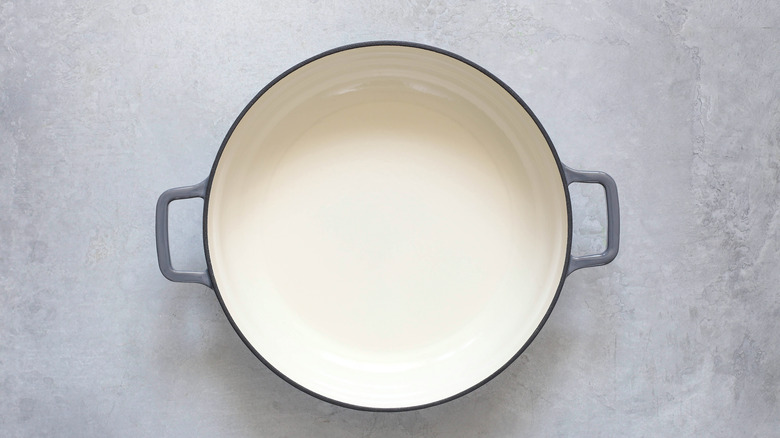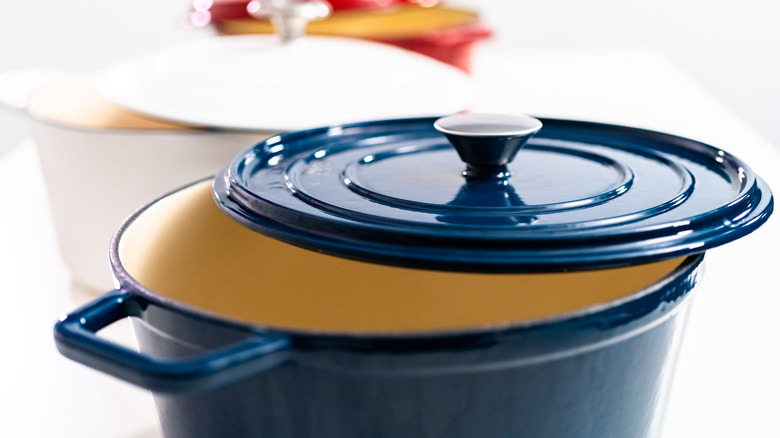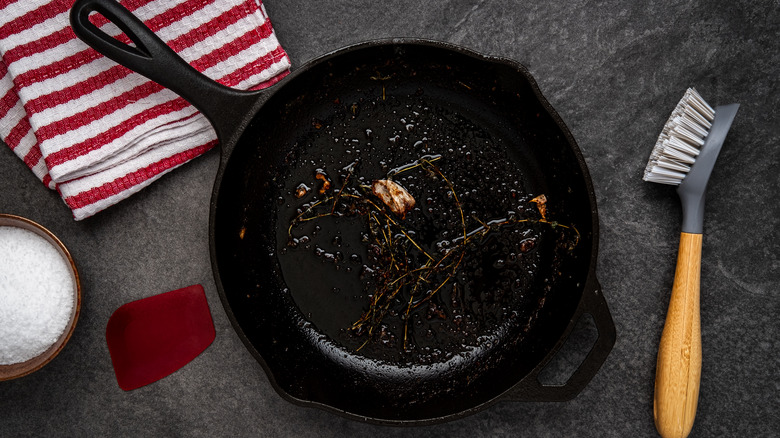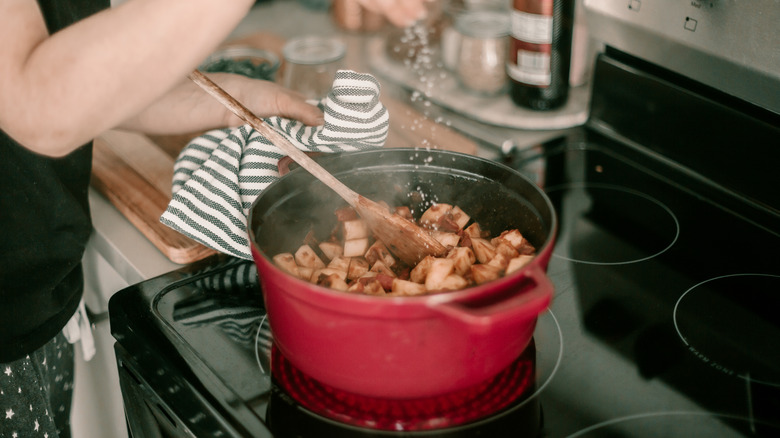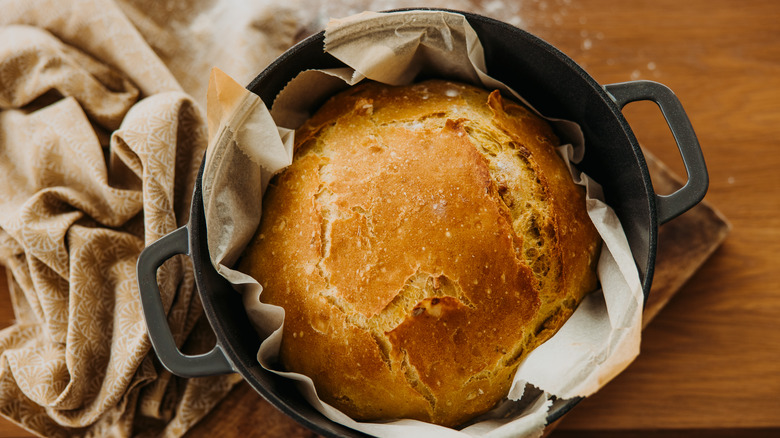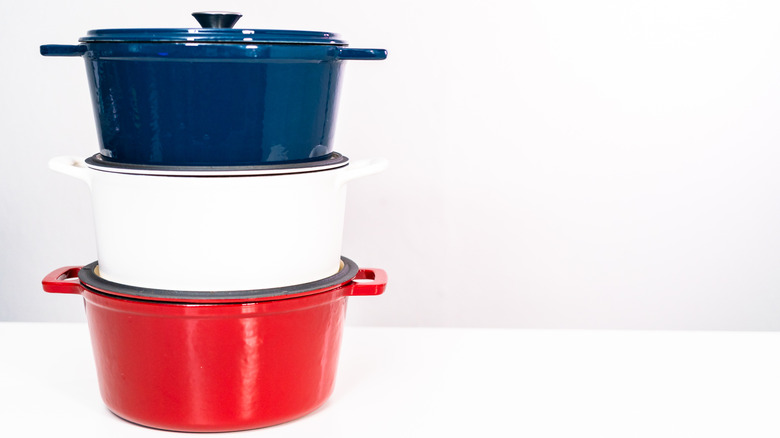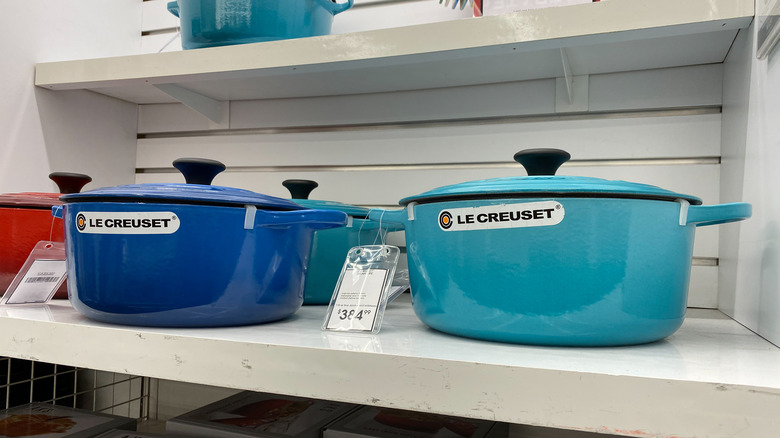Enameled Cast Iron Cookware: Everything You Need To Know Before You Buy
Enameled cast iron cookware is a useful addition to any home cook's kitchen arsenal due to its versatility and durability. It can be used for just about anything, from making soups and stews on the stovetop to baking bread and braising meat in the oven for hours, according to Wirecutter. Enameled cast iron is the best choice for heat maintenance, due to its ability to maintain a consistent temperature over a long period of time. The smooth finish of the enamel ensures that food won't stick.
When discussing her favorite pieces of kitchen equipment, Chef Nigella Lawson told Food & Wine, "I have a particular fondness for Le Creuset enameled cast-iron cookware. It not only conducts heat so well, it also seems to get more flavor out of the food." In terms of how she uses it, she says, "I slow-cook a lot in mine and however burnt they look inside, a bit of a soak in the sink and they clean easily." Both professionals and amateurs alike can get plenty of use out of enameled cast iron cookware. In this article, we'll explore everything you need to know about this cookware staple, including how it compares to bare cast iron, what to use it for, how to clean and maintain it, and how much shoppers should expect to spend.
What is enameled cast iron?
Cast iron cookware has been used for centuries to heat and prepare food. Cast iron can handle incredibly high temperatures and can be used over an open flame or in a hearth. This style of cookware is much-loved by chefs worldwide and has become a consistent presence in home kitchens as well. Bare cast iron, however, does have some drawbacks. It's notoriously tricky to care for, it can rust, and users have to maintain the seasoning that builds up on the surface.
Simply put, enameled cast iron is cast iron that has been coated with a layer of enamel, according to Uno Casa. This coating protects the cast iron core from rusting over time when exposed to moisture. It may also be referred it as porcelain enamel or porcelain cast iron. The enamel coating can be infused with pigments that create a colorful exterior, making these pieces available in a rainbow of colors that look eye-catching on a stovetop or kitchen shelf. While, in many ways, the enamel protects the cast iron, it's also vulnerable to chipping and can potentially crack if dropped.
One of the most popular styles of cookware made from enameled cast iron is the Dutch oven. Dutch ovens are shaped like large pots and can be used for various cooking applications. You'll also see enameled cast iron used for skillets, bakeware, stovetop kettles, casserole dishes, and more.
Regular vs. enameled cast iron
These two styles of cookware are both popular and do share some similarities, but have different advantages and disadvantages, according to The Washington Post. Both types of cookware can handle extremely high heat and are therefore safe to use both on the stovetop and in the oven. However, enameled cast iron heats up a bit more slowly than traditional cast iron, according to David Green, who works for the University of Virginia's School of Engineering & Applied Science as an associate professor of materials science, chemical, and mechanical engineering. It does, however, distribute heat more evenly and maintain heat more consistently. This makes enameled cast iron perfect for slow-cooking and braising at lower temperatures.
In terms of maintenance, enameled cast iron is easier to care for because home cooks needn't fret about damaging the sought-after seasoning found in bare cast iron pans. Enameled pieces don't build up a seasoning and therefore don't have the same non-stick qualities that you'd see in traditional cast iron pans. Base cast iron is, however, reactive with certain ingredients — like tomatoes and other acidic substances—so it's not ideal for cooking dishes like tomato-based sauces.
One advantage of bare cast iron is the price. Pieces without an enamel coating tend to be far more affordable, though it's still possible to find enameled cast iron pieces for a reasonable price if you stay away from the big names in the industry like Le Creuset.
How to choose a dutch oven
Dutch ovens are one of the most popular styles of enameled cast iron cookware — and for good reason. They're kitchen workhorses that can do nearly anything and make a great addition to any household. Moreover, since they can go from the stovetop to the oven, they're incredibly useful for a wide variety of recipes.
One of the major decisions shoppers need to make is concerning size. The size of a Dutch oven is measured by its total capacity in quarts. According to Wirecutter, a 5½- to 6½-quart Dutch oven is perfect for households with two to four people. However, those who often cook for a crowd should consider a larger option with a capacity of between 7 and 13 quarts. It's important to note that larger Dutch ovens can become quite heavy, especially when they're full.
Dutch ovens typically come in one of two shapes: round and oval. Round Dutch ovens are the best choice for most people because they fit on standard range burners. Oval-shaped Dutch ovens do, however, have the advantage of being able to hold a longer cut of meat like a leg of lamb or a tenderloin. Since they won't fit well on most burners, they're more useful in the oven than on the stovetop.
Most enameled cast iron Dutch ovens have pale interiors that make it easy to monitor the food you're cooking as well as the color of sauces. While some models offer dark interiors, they're not typically recommended because cooks lose the ability to clearly see the color of the pot's contents. Look for a Dutch oven with a tight-fitting lid that still allows for some steam to escape while cooking.
What can enameled cast iron cookware be used for?
When it comes to cooking with enameled cast iron cookware, the possibilities are practically endless, according to Home Cook World. You can use your enameled cast iron to sear meat, just like with bare cast iron. You'll quickly perfect the char on steaks, pork chops, chicken breasts, and fish fillets. You can also braise your meat using this kitchen tool. Begin on the stovetop to sear your meat and then transfer directly to the oven to slow roast or braise it.
Dutch ovens are perfect for making soups, stews, and chili because they retain heat, allowing users to cook at a low temperature for an extended period of time. The fact that enameled cast iron is both oven-safe and maintains a consistent temperature makes it a great tool for baking bread, which may help cut down on how many pans and gadgets clutter your cupboards and counter space.
It may not be glamorous, but an enameled cast iron pot works just as well for boiling water as a stainless steel pot — though it may take a bit longer. But, one of the best things about cooking with cast iron with an enamel coating is that you can safely cook acidic foods — something you can't do with bare cast iron. It allows cooks to use this style of cookware for creating tomato sauces, Italian-style meat sauces, and other recipes that contain a high quantity of acidic ingredients.
How to clean and maintain enameled cast iron cookware
One of the benefits of enameled cast iron cookware is that it's relatively easy to clean. Lodge, one of the top manufacturers in the industry, recommends some simple steps for cleaning and maintaining it. Technically speaking, enameled cast iron is dishwasher safe, but Lodge suggests washing pieces by hand since it's gentler and will extend the pieces' lifespans as much as possible.
The first step is to allow the cookware to cool completely before beginning the cleaning process. Then, using warm soapy water, wash the cookware with a nylon scrubbing brush. It's best to avoid citrus-based cleaning products on enameled cast iron because it may erode the glossy surface of the enamel, though it won't actually have a negative impact on the piece's performance. Avoid using any metal scrapers or scrubbers on the surface of the enameled cast iron because it could cause the material to become chipped or scratched. Nylon scrubbers, however, are safe to use for difficult stuck-on stains. Once the cleaning process is done, allow the piece to dry completely before putting it away.
In terms of storage, it's best to avoid stacking enameled cast iron pieces, and Lodge recommends using pot protectors between the lid and the pot to prevent them from scratching one another. One important additional tip is that users should always lift their enameled cast iron pieces when moving them on a stovetop to prevent inadvertently scratching glass or ceramic range tops.
How much does enameled cast iron cookware cost?
According to Kitchn, Dutch ovens range in price from about $50 for some of the more affordable brands to over $300 for top brands like Le Creuset. Oven Spot estimates that a 5.5-quart Dutch oven will cost between $90 and $360. Since it's an investment that should last for many years, experts recommend looking for an option that's well-reputed. Some of the top brands on the market include Lodge, Le Creuset, Staub, Lagostina, Cuisinart, and Tramontina.
Standard enameled cast iron pieces feature a single layer of enamel coating the cast iron core. High-end brands like Staub and Le Creuset, however, feature three layers of enamel on all of their pieces, making them more durable and less likely to chip. When choosing a product, look for models that are rated as being safe to use in a 450-degree or 500-degree oven since some lower-quality pieces have slightly lower heat thresholds.
One of the factors that cast iron and enameled cast iron have in common is that they can last for generations, and picking up second-hand pieces at a flea market or estate sale is the perfect way to get a good deal. In conclusion, a well-stocked kitchen will have both bare cast iron and enameled cast iron pieces.
